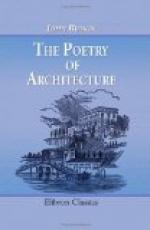72. Fig. e is also carved in stone, and where there is much variety of architecture, or where the buildings are grotesque, would be a good chimney, for the very simple reason, that it resembles nothing but a chimney, and its lines are graceful. Fig. f, though ugly in the abstract, might be used with effect in situations where perfect simplicity would be too conspicuous; but both e and f are evidently the awkward efforts of a tasteless nation, to produce something original: they have lost the chastity which we admired in a, without obtaining the grace and spirit of l and o. In fact, they are essentially German.
73. Figs. h to m, inclusive, are Spanish, and have a peculiar character, which would render it quite impossible to employ them out of their own country. Yet they are not decorated chimneys. There is not one fragment of ornament on any of them. All is done by variety of form; and with such variety no fault can be found, because it is necessary to give them the character of the buildings, out of which they rise. For we may observe here, once for all, that character may be given either by form or by decoration, and that where the latter is improper, variety of form is allowable, because the humble associations which render ornament objectionable, also render simplicity of form unnecessary.[13] We need not then find fault with fantastic chimneys, provided they are kept in unison with the rest of the building, and do not draw too much attention.
[Footnote 13: Elevation of character, as was seen in the Italian cottage, depends upon simplicity of form.]
74. Fig. h, according to this rule, is a very good chimney. It is graceful without pretending, and its grotesqueness will suit the buildings round it—we wish we could give them: they are at Cordova.
Figs. k and l ought to be seen, as they would be in reality, rising brightly up against the deep blue heaven of the south, the azure gleaming through their hollows; unless perchance a slight breath of refined, pure, pale vapor finds its way from time to time out of them into the light air; their tiled caps casting deep shadows on their white surfaces, and their tout ensemble causing no interruption to the feelings excited by the Moresco arches and grotesque dwelling houses with which they would be surrounded; they are sadly spoiled by being cut off at their bases.
75. Figs. g, n, o are Italian. Fig. g has only been given, because it is constantly met with among the more modern buildings of Italy. Figs. n and o are almost the only two varieties of chimneys which are to be found on the old Venetian palaces (whose style is to be traced partly to the Turk, and partly to the Moor). The curved lines of n harmonize admirably with those of the roof itself, and its diminutive size leaves the simplicity of form of the large building to which it belongs entirely uninterrupted and uninjured. Fig. o is seen perpetually carrying the whiteness of the Venetian marble up into the sky; but it is too tall, and attracts by far too much attention, being conspicuous on the sides of all the canals.




